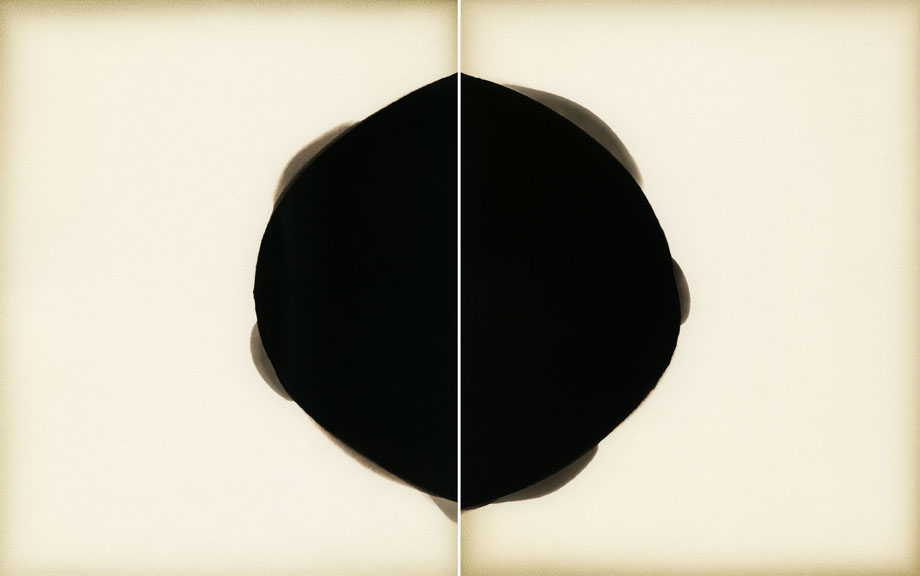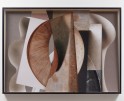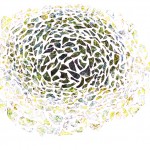Alison Rossiter: the Shpilman International Prize for Excellence in Photography 2018

“Defender Argo, expired September 1911, processed 2014”, (#6), 2014, unique silver gelatin print, 12.70 x 17.78 cm © Alison Rossiter, Courtesy Yossi Milo Gallery, New York
Photographic artist, Alison Rossiter, known for her well-celebrated lensless work that not only speaks to the history of photographic processes, but celebrates the potential of using those processes to create art, has been awarded the Shpilman International Prize for Excellence in Photography. In 2010, the Israel Museum, Jerusalem created this $40,000 biennial prize, one of the most generous in the field, with submissions being accepted only through a prior nomination process. “The award aims to support contemporary photographic projects relating to questions of the current human condition and the world of art within it.”
The museum states, “In 2018, 38 institutions from around the world nominated 66 artists, whose work was judged by a panel of international specialists: Celina Lunsford, Artistic Director of Fotografie Forum Frankfurt; Karolina Lewandowska, Photography Curator at Centre Pompidou; Falma Fshazi, former General Director of COD Art Center in Tirana; Vardit Gross, Director of ArtPort Residency Program in Tel Aviv; and Dr. Noam Gal, Curator and Head of the Department of Photography, The Israel Museum, Jerusalem.
The Prize was dedicated this year to the idea of ‘The Last Photograph,‘ exploring the place of actual photographs in our ‘virtual’ age and the changing roles of cameras as transmitters of immediate – yet never truly ‘live’ – information. The committee selected Rossiter due to her work’s originality and candor in both artistic practice and conceptual framework.
Rossiter creates photographs without the use of a camera. Captivated by the mechanics and materials of pre-digital photography, she collects decades-expired photographic paper—the oldest dating to 1900—which she develops in her darkroom, discovering what has been left behind. She has said, “I don’t make these prints, time does.”

Expired Photographic Paper Packages, about 1900 – 1920s © Alison Rossiter, Courtesy Yossi Milo Gallery, New York
Alison Rossiter was born in 1953 in Jackson, Mississippi, and lives and works in New York. A trained photographer, she worked as a photography conservator for several decades and began making camera-less photographic prints in the late 1990s. Her delicate and concentrated work is based on experimentation with expired photographic paper from specific years and places of origin. Rossiter traces these obsolete materials, giving them new life in the darkroom and creating a coherent and original language of minimalist, abstract photography that has recently gained international acclaim.
Rossiter’s interest in photographic conservation—a field she explored as a volunteer at the Metropolitan Museum of Art in 2003—informs her fascination with this obsolescent technology, reviving and rendering it viable at a time when many artists are converting to digital photography. Her ethereal, minimalist works have been exhibited in shows at the the Minneapolis Institute of Art, the National Gallery of Canada, SITE Santa Fe, the Whyte Museum in Banff, and other institutions. She has also had her work published in the New York Times‘s T magazine and elsewhere.

Expired Photographic Paper Packages, about 1920s – 1940s © Alison Rossiter, Courtesy Yossi Milo Gallery, New York
The Substance of Density, 1918–1948 Proposal
Expired photographic papers from England, France, Belgium, Germany, and the United States will be processed and assembled in groups to form a chronology from 1918 to 1948.
Since 2007 I have collected expired photographic papers produced during the 19th and 20th centuries. My archive has over eighteen hundred individual packages from several countries and represents the rise and transformation of the photography industry. It has taken me years to figure out how to use my rarest samples of silver gelatin papers to their best advantage. The assemblages of prints for The Substance of Density, 1918–1948 illustrate my chosen approach, and pieces are already in progress.
Most photographic papers produced in the United States had an exact expiration date stamped on the package. The date was a marker of quality assurance backed by the manufacturer. In my mind the specific dates of the papers recall events of world history. World War I ended in 1918, the United States economic prosperity collapsed into depression in 1929, World War II consumed 1938 through 1945, and the state of Israel was created in 1948. My emphasis in this body of work is upon the time that each sheet of paper represents.

“Density 1929, 1930”, 2018, three unique silver gelatin prints, approximate size overall: 35.56 x 48.26 cm © Alison Rossiter, Courtesy Yossi Milo Gallery, New York
No matter what the expired photographic papers endured through the dormant years, they still respond to chemical development. Even in dark storage each package of paper reacted to its surroundings. Physical damage, moisture, and mold produce tonal changes when developed, and I consider these effects to be subject matter. The resulting tones are evidence of experience.
While the Last Photograph remains to be discovered, it has left its shadow on the 20th Century. I am gathering these light sensitive traces and swaths of silver tones from my collection of expired photographic papers so that I may assemble a narrative of density. The expiration dates of the expired materials mark positions on a timeline. The proposed unique prints for Density 1918-1948 will illustrate a period of world history through an interpretation of photographic substance.
I will process sheets of expired photographic papers individually in my darkroom under safelight conditions with traditional 20th Century black and white photographic chemistry. Each print will be air dried, humidified, and flattened under plate glass. I will assemble groups of prints in adjacent configurations according to their dates. A series of years, or a single year, will be illustrated by multiple print combinations. Each print will be hinged in its four corners to a support board. This technique allows the individual sheets of silver gelatin paper to move slightly in response to any fluctuation of temperature and humidity. – Alison Rossiter

“Density 1918”, 2018, ten unique silver gelatin prints, 35.56 x 27.94 cm each print, approximate size overall: 72.39 x 142.24 cm © Alison Rossiter, Courtesy Yossi Milo Gallery, New York

“Compendium 1905 – 1909”, 2018, six gelatin silver prints, overall size: 28.5 x 32 cm © Alison Rossiter, Courtesy Yossi Milo Gallery, New York

“Compendium 1909 – 1912”, 2018, four gelatin silver prints, overall size: 28.5 x 21.5 cm © Alison Rossiter, Courtesy Yossi Milo Gallery, New York

“Compendium 1914 – 1918”, 2018, seven gelatin silver prints, overall size: 35 x 34 cm © Alison Rossiter, Courtesy Yossi Milo Gallery, New York

“Gevaert Gevaluxe Papier Velours, exact expiration date unknown, ca. 1930s, processed 2014”, 2014, unique silver gelatin print, 35.56 x 27.94 cm © Alison Rossiter, Courtesy Yossi Milo Gallery, New York

“Ilford Selo Gaslight, exact expiration date unknown, ca. 1920s, processed 2012”, 2012, unique silver gelatin print, 8.89 x 6.35 cm © Alison Rossiter, Courtesy Yossi Milo Gallery, New York

“Vephoto, exact expiration date unknown, ca. 1960s, processed 2013”, 2013, unique silver gelatin print, 21.59 x 16.51 cm © Alison Rossiter, Courtesy Yossi Milo Gallery, New York

“Agfa Brovira Kashmir White, expired June 1946, processed 2015”, 2015, two unique silver gelatin prints, 25.4 x 20.32 cm each print, overall size: 25.4 x 40.64 cm © Alison Rossiter, Courtesy Yossi Milo Gallery, New York

“Greibshaber Frères Dora, exact expiration date unknown, ca. 1900s, processed 2017”, 2017, two unique silver gelatin prints, 17.78 x 16.51 cm each print, overall size: 17.78 x 25.4 cm © Alison Rossiter, Courtesy Yossi Milo Gallery, New York

“Agfa Cykora, expired December 1944, processed 2014”, 2014, two unique silver gelatin prints, 25.4 x 20.32 cm each print, overall size: 25.4 x 40.64 cm © Alison Rossiter, Courtesy Yossi Milo Gallery, New York

“Defender Argo, expired September 1911, processed 2014”, (#1), 2014, unique silver gelatin print, 12.70 x 17.78 cm © Alison Rossiter, Courtesy Yossi Milo Gallery, New York

“Kilborn Acme Kruxo, exact expiration date unknown, ca. 1940s, processed 2013”, 2013, unique silver gelatin print, 12.70 x 17.78 cm © Alison Rossiter, Courtesy Yossi Milo Gallery, New York

“Ansco Cyko, expired September 1915, processed 2017”, 2017, four unique silver gelatin prints, 10.79 x 8.25 cm each print, overall size 21.59 x 16.51 cm © Alison Rossiter, Courtesy Yossi Milo Gallery, New York
Posts on Lenscratch may not be reproduced without the permission of the Lenscratch staff and the photographer.
Recommended
-
The Female Gaze: Alysia Macaulay – Forms Uniquely Her OwnDecember 17th, 2025
-
Bill Armstrong: All A Blur: Photographs from the Infinity SeriesNovember 17th, 2025
-
Robert Rauschenberg at Gemini G.E.LOctober 18th, 2025
-
Erin Shirreff: Permanent DraftsAugust 24th, 2025
-
Shelagh Howard: The Secret KeepersJuly 7th, 2025































































